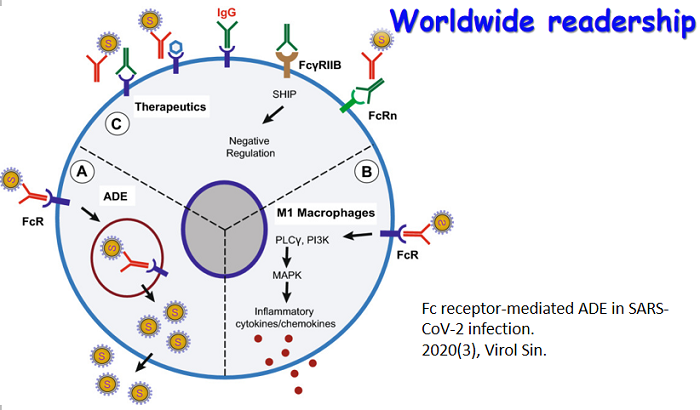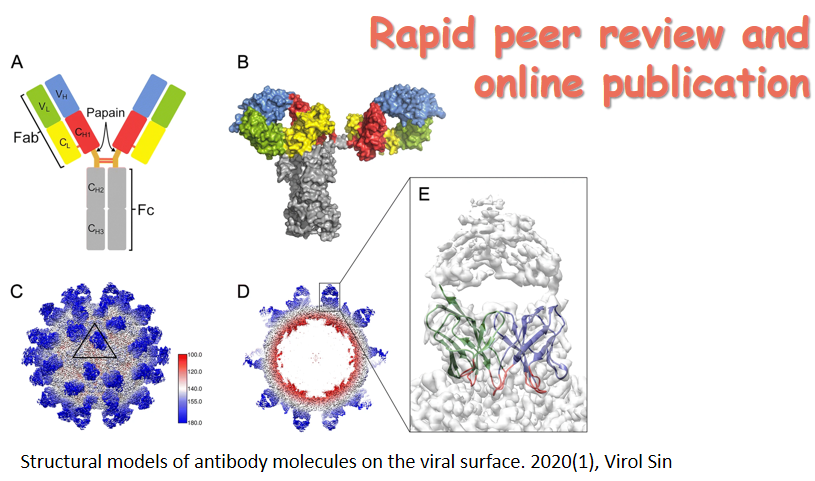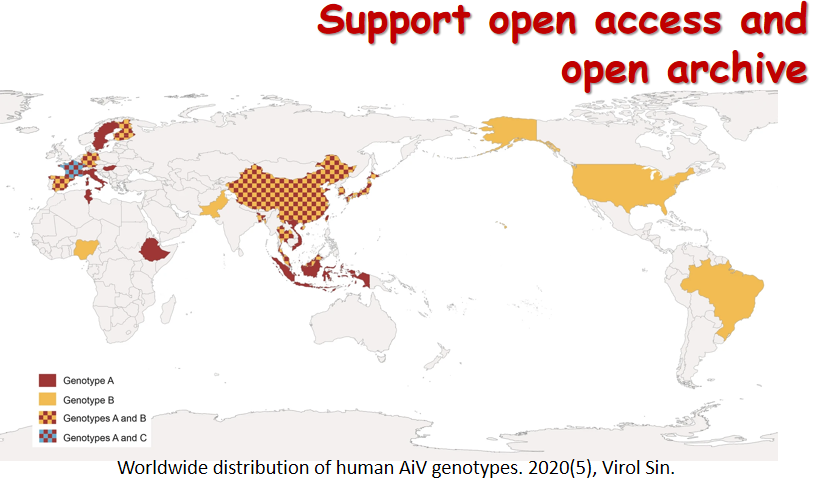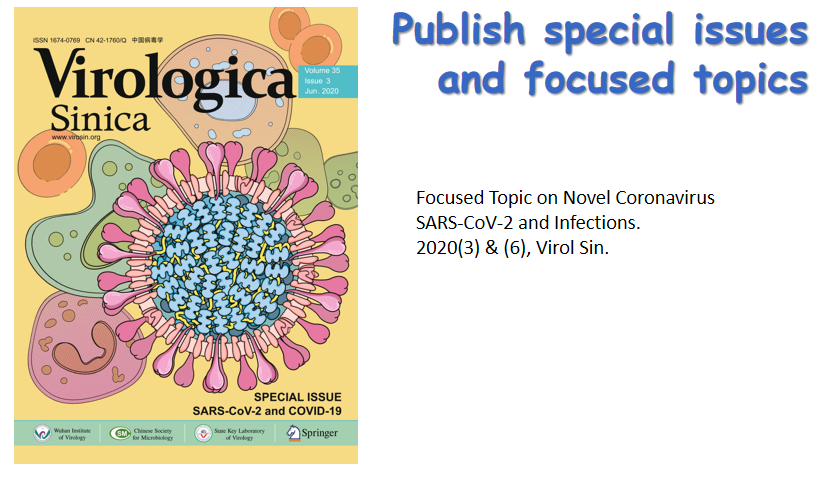|
HIV-1 integrase P31 of RL42 strain, a B subtype isolate, was expressed in E.coli using pThioHisB vector(Invitrogen). The recombinant protein represented about 30% of total cellular proteins. and was purified by inclusion body washing and Ion Exchange Chromatography (IEX). The purity of P31 protein reached more than 95%. Purified P31 antigen displayed fairly good sensitivity and specificity when prepared into immunoblot strips and tested with HIV reference sera. This work established a foundation for the development of HIV detection kits.
Approximately 8% of the population in China are carriers of HBV and about 5% have HCV infection. The underlying mechanisms of pathogenethis of the establishment of a chronic infection with HBV and HCV are not fully understood. Since there is no ideal model to explain chronic HBV and HCV infection, we have decided to attempt to establish and characterize a substitute model in C3H/HeJ mice induced by murine hepatitis viral type 3 (MHV-3). C3H/HeJ 6-8weeks old mice received 10pfu of MHV-3 intraperitoneally and 63% of them developed a chronic course of virus infection characterized by persistence of lymphocyte infiltration and macrophage activation until 40 days post infection. The mice underwent fluctuated serum ALT、AST levels and a decreased TP、ALB level. We conclude that this substitute model could be applied in studies towards understanding the mechanism of chronic viral hepatitis.
Based on a previous study, a pGL3-5’UTR plasmid was constructed by substitution of the SV40 promoter with HCV 5’UTR cDNA. A set of deletion mutant plamids: pGL3-5’UTR1 comprising the full sequence of 5’UTR; pGL3-5’UTR2 containing domains II, III and IV; pGL3-5’UTR3 containing domains I, II and III; pGl3-5’UTR4 with domains III and IV; pGl3-5’UTR5 with domains I and II were constructed. HepG2 cells were transfected with the above plasmids. The plasmid carrying the full-length of 5’UTR was transfected into hepG2, Hela, HEK293 and Hela cells. The luciferase mRNA and the enzymatic activity were then detected. The relative luciferase activity associated with the pGL3-5’UTR1, pGL3-5’UTR2, pGL3-5’UTR3, pGL3-5’UTR4 and pGL3-5’UTR5 were 5.91±0.65, 9.52±0.32, 2.72±0.45, 2.64±0.25 and.32±0.09, respectively. The luciferase activity was evident in all four cell lines. The data suggested that the DNA sequence of stem-loop III was the core structure and the domain I, II and IV had a regulating effect. It also showed that cells originated from various tissues could provide efficient accessory factors for HCV 5’UTR sequence than strictly act as a promoter and that the original cells may be the most suitable.
The effect and mechanism of antimicrobial lipopeptide (AMI) produced by a Bacillus subtilis fmbJ strain against Pseudorabies virus (PRV) and Porcine parvovirus (PPV) were studied. The Median Toxicosis Dose (TD50) and TD0 values of AMI on Porcine Kidney (PK-15) cells were 47.57mg/L and 18.9 mg/L, respectively. AMI strongly inhibited the cytopathic effect induced by PRV and PPV, and increase the survival rate of cell remarkably. However, it did not inhibit infection and multiplication of PPV and PRV in PK-15 cells. This study indicated that the antimicrobial lipopeptide could affect PRV and PPV directly but precluded infection of PK-15 cells. the effect of AMI in PK-15 cells was markedly lower than the antiviral drug Acyclovir (ACV). Since it had lower toxicity to PK-15 cell, we would study it further as an antiviral drug.
In order to confirm the etiology of the first suspected human case of the highly-pathogenic avian influenza virus and to perform the pathogenicity studies, a tracheal aspirate specimen was tested by RT-PCR, Real-time PCR and virus isolation. In addition, the HI (hemagglutination-inhibition) antibody in serum samples was assayed. The results showed that RNA extracted from the tracheal aspirate specimen was positive for H5N1 avian influenza virus and influenza virus type A. The H5N1 avian influenza virus was named A/Zhejiang/16/06 (H5N1). The titers of HI antibody for H5N1 avian influenza virus were 1: 320 and 1: 640, respectively. Both the pathogenic and serologic tests confirmed the human case of H5N1 avian influenza virus infection. The results of HA (hemagglutination) gene sequencing revealed that there were multiple basic amino acids at the cleavage site of HA gene associated with highly pathogenic H5 avian virus. The HA、NA、PB2、NP、M and NS genes were all of avian origin and were very similar to that of H5N1 avian influenza virus isolated from Fujian and Anhui provinces in 2005. However, there were obviously differences compared with the strains isolated from Vietnam、Thailand and Hong Kong in 1997.
Syncytin, a captive retroviral envelope protein, is possibly involved in the morphogenesis of the placental syncytiotrophoblast layer generated by trophoblast cell fusion. It is found that syncytin and HIV-1 envelope proteins share similar structural profiles and membrane fusion mechanisms. In this article, we carried a mutagenesis by PCR to the conserved intramolecular disulfide bond of the linker between the heptad repeats HR1 and HR2 in the fusion core. We expressed and purified the mutant protein and subsequently the structure and stability were tested. After comparing the characteristics between the native and the mutant proteins, we got the concluded that this conserved intramolecular disulfide bond made a certain function in the correct protein structure formation and stability.
In order to amplify the complete genome of Jaagsiekte sheep retrovirus (JSRV) Inner Mongolia Strain, eight pairs of primers were designed based on Genbank sequences. Eight fragments were obtained by PCR and were cloned into the pMD-18 T vectors . The recombinant plasmids were sequenced and the complete sequences were analyed with DNA Star. The results showed that the genome was 7430bp in length and contained four overlapping open reading frames of the gag, pro, pol and env genes. The nucleotide and amino acid sequences of NM strain were compared with the sequences of South Africa strain (type I, Accession No. NC-001494) and USA strain (type II, Accession No. AF105220). The nucleotide and amino acid identities were 90.4% and 90%, 90% and 89.1%, respectively. Two zinc fingers were found in the region of NC in the predicted amino acid sequence. A ScaⅠ restriction site in gag was found in the sheep genome, The “YXXM” motif was found in the region of TM, which are reliable molecular markers for the infectious exogenous virus. The exJSRV-2 specific DNA fragment probe was labeled with digoxigenin (Dig) and the Jaagsiekte retrovirus NM strain RNA and proviral DNA in the lung tissue of OPA were detected by in situ hybridization. The results showed JSRV-NM mRNA and provirus DNA in sheep lung tumor cells had very strong hybridization signals while the control group did not have a positive signal. This is the first nucleotide sequence of exJSRV reported in China.
In this study, an improved real-time RT-PCR was applied to quantification of Foot-and-mouth disease virus in vivo and in vitro. The results suggested that this method had a high sensitivity with up to less than 10 copies / reaction. Furthermore, this novel method was successfully used to quantify the transcriptional level of FMDV-3D gene in transfected BHK-21 cells and the resultant concentration of RNA level was up to 6.9×10 4 copies/μL. Compared with SYBR GreenⅠRT-PCR, six of eight samples testing the FMDV RNA copy number was up to 6.7-fold higher when determined by TaqMan RT-PCR, indicating that the improved method shows a high sensitivity in virus detection.
In this study, recombinant expression plasmid pQE-Tri/P1+2A was constructed and then transfected into BHK-21 cell line mediated by liposome 2000. The results of SDS-PAGE、Western-blotting、fluorescence antibody and ELISA showed that FMDV P1+2A protein was expressed in BHK-21 cell line successfully and can be recognized by FMD positive serum. The result will lay a foundation for study of FMDV gene engineered vaccines as well as the development of diagnostic reagents.
Membrane (M) protein genes of Canine coronavirus (CCoV) domestic strain DXMV, V1 and V2 were successfully amplified, sequenced and analyzed. The full length of all the M gene of DXMV, V1 and V2 strains was 792 bp, encoding 263 amino acids. The initial 17 amino acids as appeared to be a signal peptide. Compared with the strain Insavc-1, the identities of nucleotide sequences and deduced amino acid sequences were 92.6% and 92.5% for strain DXMV, 90.9% and 92.0% for strain V1, 91.6% and 92.3% for strain V2, respectively. The variation was mainly in the one third 5’ regions of M gene, particularly in the regions of the 74-76, 120-124 and 131-135 nucleotides. The identities of nucleotide sequences and deduced amino acid sequences among 5 domestic strains were 96.6% and 96.4%, respectively. Phylogenetic tree based on the M genes showed that most domestic strains belong to CCoV genotype II, while Fox3-1and Rac2-1 are classified into genotype I. The M gene of strain DXMV was subcloned into pET28a expression vector. The recombinant M protein was successfully expressed in BL21(DE3), which amounted to 10.2 percent of the total bacterial protein.
A pair of primers were designed based on the PrV ul24 gene sequence in GenBank (NC006151). The UL24 protein coding sequence was amplified by PCR from PrV RongA strain genomic DNA. The product was cloned into pEGFP-N1 vector to generate the plasmid pUL24-GFP. Restriction endonuclease digestion, DNA sequencing and Western blots were employed to identify and authenticate pUL24-GFP. The ul24 DNA sequencing result was submitted to GenBank (DQ226544). Western blot analysis indicated that the UL24-GFP fusion protein was 45KD. After transfection of pUL24-GFP into eukaryotic cells, the intracellular localization of UL24-GFP fusion protein was examined by confocal microscopy and the result indicated that the fusion protein was localized mainly in nucleus.
A pair of primers were designed and synthesized based onthe genomic sequences of the Nucleocapsid gene of IBV in Genbank. The gene encoding the nucleocapsid protein (N) was amplified by RT-PCR. Sequencing data showed that the complete gene encoding the nucleocapsid of IBV isolate (793/B) consisted of 1229 nucleotides. Sequence analysis showed that 88 point mutations were found in the N gene, and one nucleotide was deleted inform position 991. By comparison with 11 strains in GenBank, the sequence identity was 86.9%~91.4%, and the identity of the deduced amino acids was 75.8%~77.5%. The results showed that there were major variatons in the N gene of 793/B.
A real-time reverse transcription-polymerase chain reaction (RRT-PCR) assay based on TaqMan-MGB probe was developed to rapidly detect avain influenza virus subtype H5. The assay, which was based on primers and TaqMan-MGB probes selected from highly conserved regions of the hemagglutinin gene of avain influenza virus subtype H5, was optimized in a reaction system and a condition to improve the sensitivity, specificity and accuracy. In addition, colone technology was used to develop a quantitative PCR format with virus copies amount. The results showed that the best concentration of primers and probe was 640nmol/L and 480nmol/L, respectively. None of the negative control samples showed false-positive reactions when done in duplicates. The detection limit of the assay was 100 copies per reaction. A linear standard curve was obtained between 102 and 107 DNA copies/reaction. It took only three hours from viral RNA extraction to complete the detection. The assay was simple and highly reproducible. This real-time RT-PCR assay is an excellent method suitable for rapid and quantitative detection of avian influenza virus H5 under clinical conditions.
The coding region of capsid protein gene from Chicken Anemia virus(CAV) was amplified from pPro-VP1 by PCR and cloned into pET-30a(+). E.coli BL21(DE3)were transformed by the recombinant plasmid pET30-VP1. Analysis by SDS-PAGE and Western blot showed that the target gene was expressed successfully in the form of inclusion body when induced with IPTG. The protein was then purified by Ni2+-affinity chromatography and used to immunize female Balb/c mice. After three rounds of immunizations, antiserum was collected and used to detect the specificity of recombinant protein. ELISA showed that the titer of antiserum was above 1:12800. Moreover, antiserum reacted specifically with purified recombinant protein in Western blot. This study laid a foundation for the development of CAV diagnostic kit and vaccine.
A Plasmid DNA vaccine pcDNA-gB expressing gB protein of infectious laryngotracheitis virus(ILTV) Yantai strain was constructed. The expression of viral protein from constructed DNA vaccine was confirmed by an in vitro transcription /translation system and transtection in 293-T cells. To evaluate the prophylactic efficacy of the DNA vaccine, 4-week-old chickens were inoculated with pcDNA-gB plasmid and rFPV- gB-gD-IgY, respectively followed by a booster of rFPV-gB-gD-IgY and pcDNA-gB. Anti-ILTV antibodies and T cell proliferation were detected. The results indicated that both vaccines could elicit specific humeral immune and cellular immune responses. Compared with attenuated vaccines, rFPV-gB-gD-IgY/pcDNA-gB elicited not only similar antibody level of ILTV but stronger T cell proliferation.The study lays foundation on further investigation for the new type of vaccines against ILTV.
A fluorescent quantitative PCR (FQ-PCR) method based on sequences of the conserved gE of the PRV genome was established and evaluated after selection of optimal reaction conditions. A pair of primers and a fluorescent TaqMan probe specific for gE gene were designed and used. We compared the FQ-PCR assay to conventional virus culture techniques and PCR test. According to our results, the dynamic range of the FQ-PCR assay is between 1.0×102 copies/L and 1.0×107copies/L, and the lowest DNA concentration of detection is 1.0×102 copies/L, which is 10 fold better than regular PCR and also avoids non-specific amplification occasionally seen in regular PCR. We tested 66 specimens from different pig farms in Hubei, Henan and Gansu in 2005 by the FQ-PCR assay and isolates of PRV were found in 42 samples (63.6%). In conclusion, the FQ-PCR method is rapid, sensitive, specific and accurate and can be used to rapidly detect wild type PRV from pig’s tissues and respirator specimens.
Four gene fragments of S1 strain of porcine reproductive and respiratory syndrome virus were amplified by RT-PCR and cloned into the pCR-XL-TOPO vector for sequencing. Authentic 5′ and 3′ terminal fragments of S1 strain were obtained by 5′ -Full RACE Core Set and 3′ -Full RACE Core Set and cloned into the pMD-18T vector and sequenced. The complete nucleotide sequence of S1 strain genome was obtained by sequential splicing of each fragment. The results showed that the genome of S1 strain was 15441 bp in length, containing nine open reading frames (ORFs), with 189 nt in the 5’ UTR and 181 nt in the 3’ UTR, including 30 nt poly (A) tail. The genome of PRRSV S1 strain showed 99.5%, 99.6% and 90.8% of nucleotide identity with ATCC VR-2332, BJ-4 and CH-1a, respectively.
With the software BLAST from NCBI , the unique gene ORF22 and gene ORF40 of Spodoptera exigua nuclear polyhedrovirus (SeMNPV) were selected and cloned into the pMD18-T vector. The purified pMD18-T-ORF22 and pMD18-T-ORF40 were used as standard samples, genome of quantified SeMNPV were used as control, a real-time TaqMan-based PCR assay was developed to rapidly detect valid quantity of SeMNPV. The equation of standard curves were con=10(-0.282CT+9.965) (R2=0.9997)and con=10(-0.296CT+9.945) (R2=0.9995. This study indicated that a SeMNPV polyhedrobody contained 102 nucleic molecules. SeMNPV complex as detection sample contained 633 PIBs/mg、691 PIBs/mg SeMNPV polyhedrobodies, the two methods were in accordance with each other, and was in accordance with the actual quantity in the samples.
In this study, the bacterium strains from Takramagan in Xinjiang, which was characteristic with high temperature and strong ultraviolet (UV) radiation in summer, were isolated, purified and identified. The acetone extracts of 39 isolated strains were measured by HPLC and UV-visible detection and their free radical scavenging abilities were determined using UV induction of bacteriophage λ, respectively. The results showed that the main compounds of most extracts were carotenoids and the extracts of 29 strains could protect the bacteriophage λ against UV radiation with different efficiency, the maximum inhibitory rate of which can be up to 81%. By comparison of the strains, it was found that the strains in different genus were obviously different in the protective abilities against UV radiation, and the strain of Methylobacterium showed the strongest among them. Strains with different colors belonging to different genus showed different effect, so did the strains of Kocuria. This paper revealed that carotenoid was one of the key factors for protecting the strains against UV radiation. Furthermore, the UV induction of bacteriophage λ proved to be a very useful model for studying the radiation resistance of different substance.
A new tospovirus was discovered in infected peanut plants based on complete sequencing and analysis of its genomic S RNA. It was characterized as a new strain of Capsicum chlorosis virus (CaCV) and was named China peanut (CP) strain. The total sequence of S RNA of CaCV-CP was 3399 nucleotide (nt) and contained two open reading frames (ORFs) with an ambisense arrangement. ORF1 was 1320nt encoding a 49.9 kDa nonstructural (NSs) protein. ORF2 is 828nt encoding a 30.7 kDa nucleocapsid (N) protein. The N gene of CaCV-CP shared 84.7%~86.4% and 92.4%~93.1% identity with that of CaCV strains from Thailand and Australia at the nucleotide and amino acid levels, respectively. This is the first report of complete sequence of CaCV S RNA and occurrence of CaCV in China.
The association between transcriptional activation of HERV and the develop- ment of schizophrenia was investigated. Nested RT-PCR was used to detect the preval- ence of HERV env RNA in the PBMCs of individuals with recent-onset of schizophrenia and normal persons from central and southern China. β-actin gene was used as an internal control. HERV env homologous sequences were found in the PBMCs of 8 of 28 (28.6%) individuals with recent-onset schizophrenia, while no env sequences were identified in any of the PBMCs obtained from 24 normal person (P0.001). The results suggested that transcriptional activation of HERV might be associated with the develop- pment of schizophr- enia in at least some patients.
Hepatitis A virus and ECHO20 viruses were isolated from faeces of hepatitis A patients in Luxi County, Yunnan Province. The combined and single serological neutralization antibody tests of enterovirus demonstrated that the patients were infected by both viruses. One strain, named LX0901, was selected for RT-PCR by using the general primers of VP1 of enterovirus. The product was purified and sequenced. The data were deposited in GenBank and compared with the complete VP1 sequence of 3 isolated ECHO20 strains. Analysis indicated that the LX0901 strain was ECHO20 virus, which was in agreement with serological neutralization tests. The variations of amino acids were not so high with an identity of more than 97%, but the variation were distributed throughout the genome.
The coat protein gene and its 3′ noncoding region of a watermelon isolate of Cucumber green mottle mosaic virus (CGMMV-LN) in Liaoning, China was determined and compared with other isolates. The gene encoding the coat protein of CGMMV-LN comprises of 486 nucleotides and encodes a putative protein of 161 amino acids. Sequence comparisons showed that the coat protein of this isolate was identical to that of seven CGMMV isolates infecting cucurbits in Europe and Asia. The 3′ noncoding region of CGMMV-LN consists of 176 nucleotides, which is same as that of CGMMV-KOM, CGMMV-KW and CGMMV–SH.
















